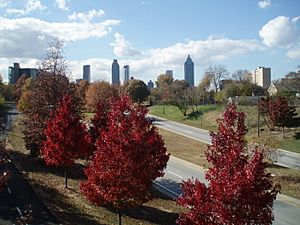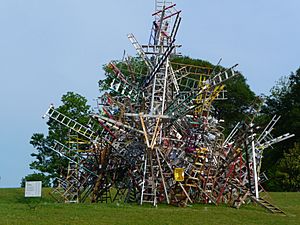Freedom Park (Atlanta, Georgia) facts for kids
Freedom Park is one of the biggest parks in Atlanta, Georgia, United States. It's shaped like a cross, with the Carter Center right in the middle. The park stretches from west to east and north to south, connecting different parts of the city.
John Lewis Freedom Parkway is a special four-lane road that goes through the park. It was renamed in 2018 to honor John Lewis. He was a famous U.S. Congressman and a very important leader in the civil rights movement. This parkway is part of Georgia State Route 10. It travels through the park from the Downtown Connector to the Carter Center.
The Story of Freedom Park
In the 1960s, the Georgia Department of Transportation planned to build two large highways in Atlanta. One road would go north-south, and another would go east-west. A big interchange, like a giant road crossing, was planned where the Carter Center is now. To build these roads, the state bought land and tore down about 500 homes.
But many local people protested against these highways. They didn't want their neighborhoods destroyed. Thanks to their efforts and the help of then-Governor Jimmy Carter, the highway project was stopped in the 1970s.
The land sat empty for over 20 years. Then, Atlanta was chosen to host the 1996 Summer Olympics. This led to a new plan. The parkway was finally completed, but as a smaller road. The rest of the land was turned into a beautiful linear park.
Freedom Park, covering 207 acres, was officially opened on September 19, 2000. Important people like Jimmy Carter, Governor Roy Barnes, and Mayor Bill Campbell were there. Since then, the park has become a popular place for outdoor art, jogging, bike riding, and dog-walking.
In 2012, the BeltLine's Eastside Trail opened. This trail crosses the Freedom Park Trail, connecting it to a large network of parks and trails around Atlanta.
In August 2018, "Freedom Parkway" was renamed "John Lewis Freedom Parkway." This honored John Lewis, who was a key leader in the civil rights movement. He participated in important events like the 1961 Freedom Riders and the 1963 March on Washington for Jobs and Freedom.
Where is Freedom Park?
The main part of John Lewis Freedom Parkway runs east from the Downtown Connector (I-75/85). Then it turns north at the Carter Center towards Ponce de Leon Avenue. This section is known as SR 10. Another part, called "John Lewis Freedom Parkway East," goes around the Carter Center. It connects to Moreland Avenue, near the Fulton and DeKalb county line. This area is part of the Poncey-Highland neighborhood.
Near the Carter Center, the parkway has some interesting features. There's a radio tower right next to the road. The parkway goes through an underpass at this spot. This underpass isn't for another road. It's actually there to stop ice from falling onto the road or cars during winter storms. Ice could fall from the tower itself or from its guy wires, which stretch over the road.
Art in the Park
Freedom Park has some wonderful public art. One sculpture is called Homage to King. It was created in 1996 by artist Xavier Medina-Campeny from Barcelona. This artwork shows Martin Luther King Jr. with his arm outstretched, welcoming visitors. It's located near Boulevard, close to the Martin Luther King Jr. National Historical Park.
Another important sculpture is The Bridge, made in 1997 by Thornton Dial. This artwork is near Ponce de Leon Avenue. It represents Congressman John Lewis's lifelong fight for civil and human rights. It also honors the community's brave efforts to stop the highways and save their neighborhoods.





